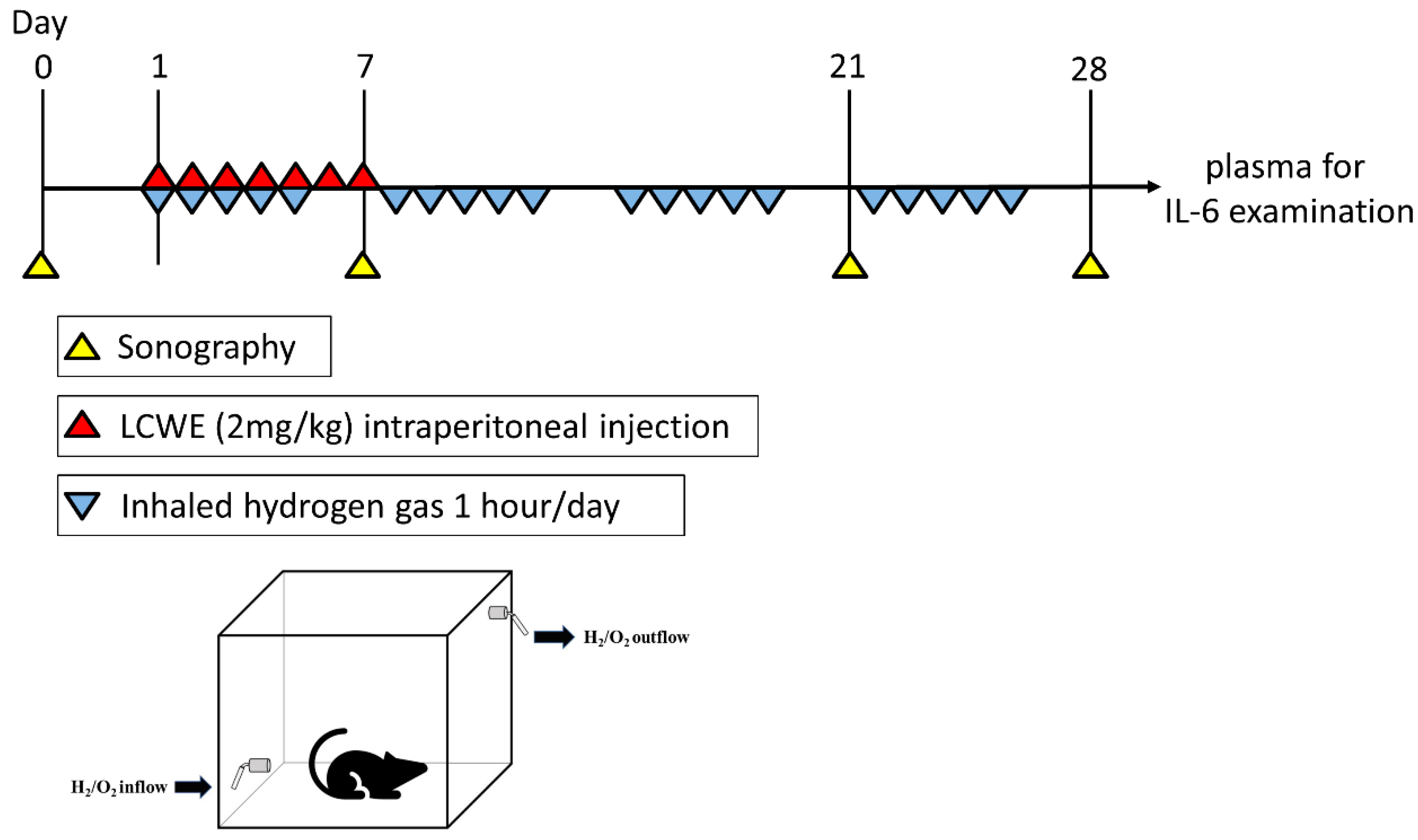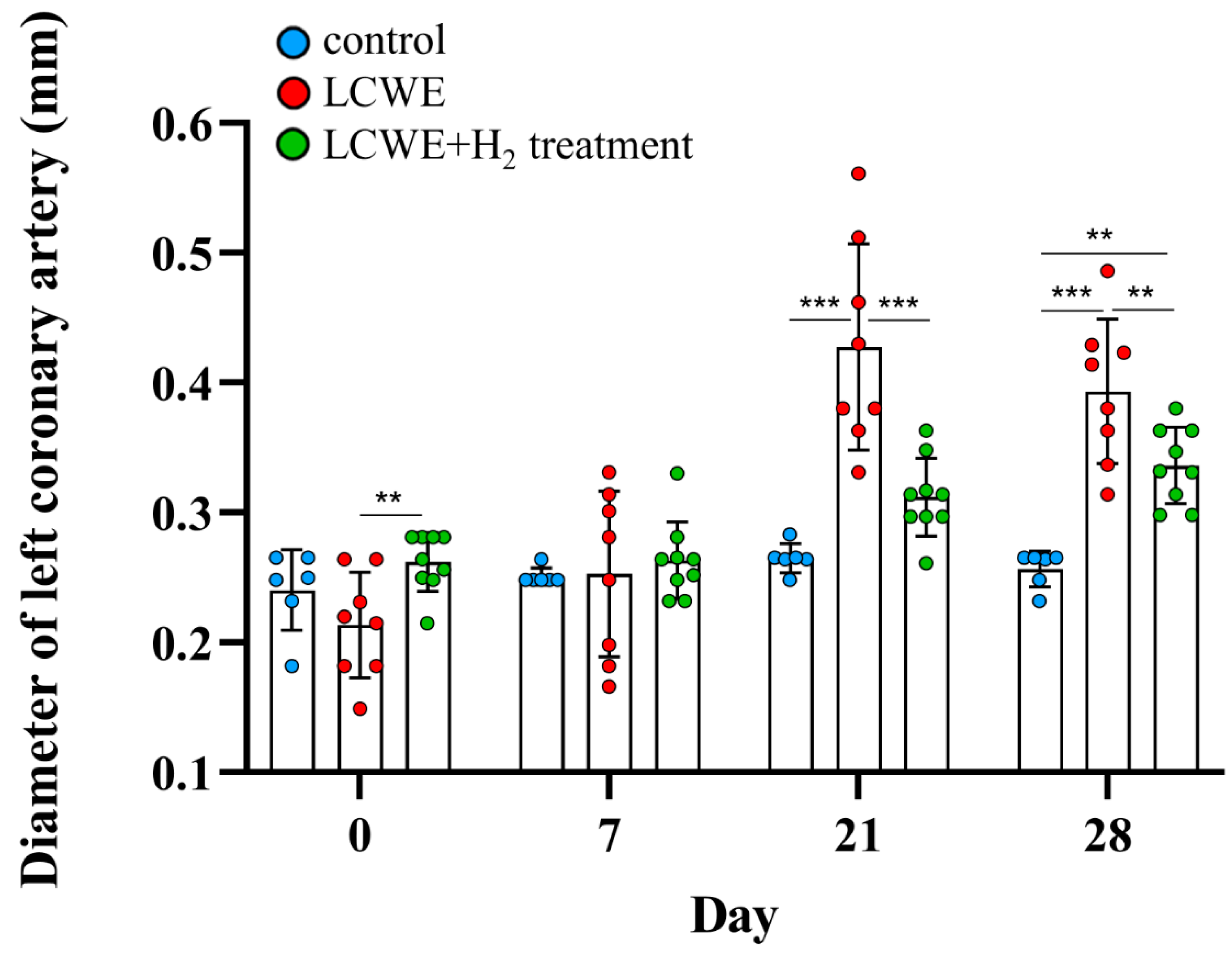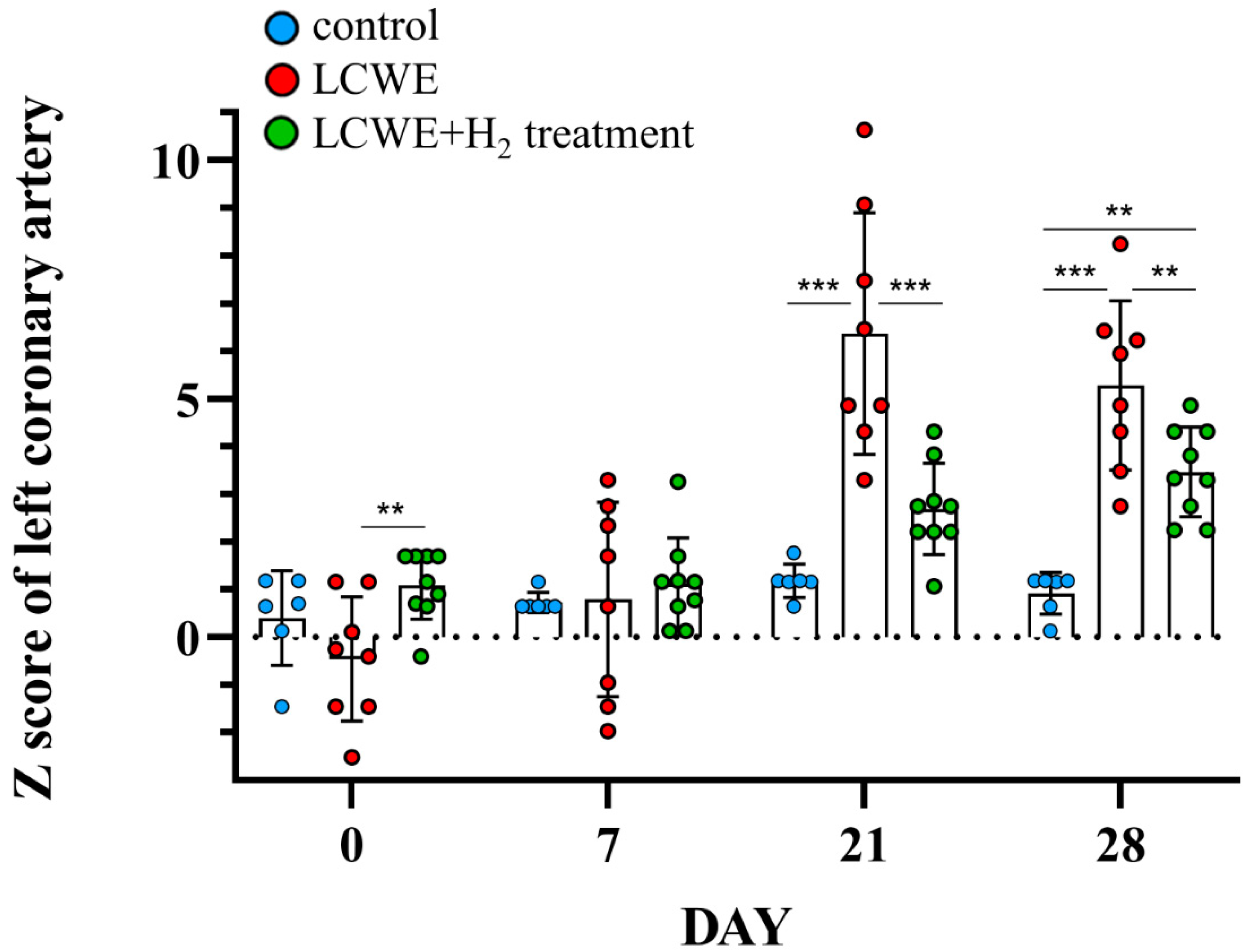Hydrogen Gas Inhalation Treatment for Coronary Artery Lesions in a Kawasaki Disease Mouse Model
Abstract
1. Introduction
2. Methods
2.1. Ethics Statement and Animal Protocol
2.2. LCWE-Induced KD Vasculitis Murine Model
2.3. Hydrogen Gas Inhalation
2.4. Echocardiographic and Z Score
2.5. Measurement of Interleukin-6 Using Enzyme-Linked Immunoassay
2.6. Statistical Analysis
3. Results
3.1. Resolution of Dilatation of CALs in LCWE-Injected Mouse Model Following Treatment with Inhaled Hydrogen Gas
3.2. Plasma Interleukin 6 in the LCWE Murine Model of KD Vasculitis
4. Discussion
5. Conclusions
Author Contributions
Funding
Institutional Review Board Statement
Informed Consent Statement
Data Availability Statement
Conflicts of Interest
List of Abbreviations
| KD | Kawasaki disease |
| IVIG | intravenous immunoglobulin |
| CAL | coronary artery lesions |
| IL-6 | interleukin 6 |
| LCWE | Lactobacillus casei cell wall extract |
| ROS | reactive oxygen species |
| LCA | left coronary artery |
References
- Sapountzi, E.; Fidani, L.; Giannopoulos, A.; Galli-Tsinopoulou, A. Association of Genetic Polymorphisms in Kawasaki Disease with the Response to Intravenous Immunoglobulin Therapy. Pediatr Cardiol. 2023, 44, 1–12. [Google Scholar] [CrossRef]
- Rajasekaran, K.; Duraiyarasan, S.; Adefuye, M.; Manjunatha, N.; Ganduri, V. Kawasaki Disease and Coronary Artery Involvement: A Narrative Review. Cureus 2022, 14, e28358. [Google Scholar] [CrossRef] [PubMed]
- Kawasaki, T.; Kosaki, F.; Okawa, S.; Shigematsu, I.; Yanagawa, H. A new infantile acute febrile mucocutaneous lymph node syndrome (MLNS) prevailing in Japan. Pediatrics 1974, 54, 271–276. [Google Scholar] [CrossRef]
- Scherler, L.; Haas, N.A.; Tengler, A.; Pattathu, J.; Mandilaras, G.; Jakob, A. Acute phase of Kawasaki disease: A review of national guideline recommendations. Eur. J. Pediatr. 2022, 181, 2563–2573. [Google Scholar] [CrossRef] [PubMed]
- Aquilano, K.; Zhou, B.; Brestoff, J.R.; Lettieri-Barbato, D. Multifaceted mitochondrial quality control in brown adipose tissue. Trends Cell Biol. 2023, 33, 517–529. [Google Scholar] [CrossRef]
- Flores-Romero, H.; Dadsena, S.; Garcia-Saez, A.J. Mitochondrial pores at the crossroad between cell death and inflammatory signaling. Mol. Cell 2023, 83, 843–856. [Google Scholar] [CrossRef]
- Vringer, E.; Tait, S.W.G. Mitochondria and cell death-associated inflammation. Cell Death Differ. 2023, 30, 304–312. [Google Scholar] [CrossRef]
- Yin, H.; Feng, Y.; Duan, Y.; Ma, S.; Guo, Z.; Wei, Y. Hydrogen gas alleviates lipopolysaccharide-induced acute lung injury and inflammatory response in mice. J. Inflamm. 2022, 19, 16. [Google Scholar] [CrossRef] [PubMed]
- Yang, H.; Liu, S.; Du, H.; Hong, Z.; Lv, Y.; Nie, C.; Yang, W.; Gao, Y. Hydrogen Attenuates Myocardial Injury in Rats by Regulating Oxidative Stress and NLRP3 Inflammasome Mediated Pyroptosis. Int. J. Med. Sci. 2021, 18, 3318. [Google Scholar] [CrossRef]
- Wang, C.L.; Wu, Y.T.; Lee, C.J.; Liu, H.C.; Huang, L.T.; Yang, K.D. Decreased nitric oxide production after intravenous immunoglobulin treatment in patients with Kawasaki disease. J. Pediatr. 2002, 141, 560–565. [Google Scholar] [CrossRef]
- Marek-Iannucci, S.; Ozdemir, A.B.; Moreira, D.; Gomez, A.C.; Lane, M.; Porritt, R.A.; Lee, Y.; Shimada, K.; Abe, M.; Stotland, A.; et al. Autophagy-mitophagy induction attenuates cardiovascular inflammation in a murine model of Kawasaki disease vasculitis. JCI Insight 2021, 6, e151981. [Google Scholar] [CrossRef] [PubMed]
- Shahi, A.; Afzali, S.; Firoozi, Z.; Mohaghegh, P.; Moravej, A.; Hosseinipour, A.; Bahmanyar, M.; Mansoori, Y. Potential roles of NLRP3 inflammasome in the pathogenesis of Kawasaki disease. J. Cell. Physiol. 2023, 238, 513–532. [Google Scholar] [CrossRef]
- Marek-Iannucci, S.; Yildirim, A.D.; Hamid, S.M.; Ozdemir, A.B.; Gomez, A.C.; Kocaturk, B.; Porritt, R.A.; Fishbein, M.C.; Iwawaki, T.; Rivas, M.N.; et al. Targeting IRE1 endoribonuclease activity alleviates cardiovascular lesions in a murine model of Kawasaki disease vasculitis. JCI Insight 2022, 7, e157203. [Google Scholar] [CrossRef]
- Noval Rivas, M.; Arditi, M. Kawasaki disease: Pathophysiology and insights from mouse models. Nat. Rev. Rheumatol. 2020, 16, 391–405. [Google Scholar] [CrossRef]
- Shih, W.L.; Yeh, T.M.; Chen, K.D.; Leu, S.; Kuo, H.C. Positive Echocardiographic Association between Carotid Artery and Coronary Artery Diameter and Z-Score in a Mouse Model of Kawasaki Disease. Diagnostics 2024, 14, 145. [Google Scholar] [CrossRef]
- Lin, I.C.; Suen, J.L.; Huang, S.K.; Huang, S.C.; Huang, H.C.; Kuo, H.C.; Wei, C.C.; Wang, F.S.; Yu, H.R.; Yang, K.D. Dectin-1/Syk signaling is involved in Lactobacillus casei cell wall extract-induced mouse model of Kawasaki disease. Immunobiology 2013, 218, 201–212. [Google Scholar] [CrossRef]
- Wang, N.; Chen, Z.; Zhang, F.; Zhang, Q.; Sun, L.; Lv, H.; Wang, B.; Shen, J.; Zhou, X.; Chen, F.; et al. Intravenous Immunoglobulin Therapy Restores the Quantity and Phenotype of Circulating Dendritic Cells and CD4(+) T Cells in Children With Acute Kawasaki Disease. Front. Immunol. 2022, 13, 802690. [Google Scholar] [CrossRef]
- Chen, K.D.; Huang, Y.H.; Wu, W.S.; Chang, L.S.; Chu, C.L.; Kuo, H.C. Comparable bidirectional neutrophil immune dysregulation between Kawasaki disease and severe COVID-19. Front. Immunol. 2022, 13, 995886. [Google Scholar] [CrossRef]
- Chen, K.D.; Lin, W.C.; Kuo, H.C. Chemical and Biochemical Aspects of Molecular Hydrogen in Treating Kawasaki Disease and COVID-19. Chem. Res. Toxicol. 2021, 34, 952–958. [Google Scholar] [CrossRef]
- Suganuma, E.; Sato, S.; Honda, S.; Nakazawa, A. A novel mouse model of coronary stenosis mimicking Kawasaki disease induced by Lactobacillus casei cell wall extract. Exp. Anim. 2020, 69, 233–241. [Google Scholar] [CrossRef]
- Tsuda, E.; Kamiya, T.; Ono, Y.; Kimura, K.; Kurosaki, K.; Echigo, S. Incidence of stenotic lesions predicted by acute phase changes in coronary arterial diameter during Kawasaki disease. Pediatr. Cardiol. 2005, 26, 73–79. [Google Scholar] [CrossRef]
- Tsuge, M.; Uda, K.; Eitoku, T.; Matsumoto, N.; Yorifuji, T.; Tsukahara, H. Roles of Oxidative Injury and Nitric Oxide System Derangements in Kawasaki Disease Pathogenesis: A Systematic Review. Int. J. Mol. Sci. 2023, 24, 15450. [Google Scholar] [CrossRef] [PubMed]
- Zhu, Q.; Dong, Q.; Wang, X.; Xia, T.; Fu, Y.; Wang, Q.; Wu, R.; Wu, T. Palmitic Acid, A Critical Metabolite, Aggravates Cellular Senescence Through Reactive Oxygen Species Generation in Kawasaki Disease. Front. Pharmacol. 2022, 13, 809157. [Google Scholar] [CrossRef]
- Hu, J.; Qian, W.; Yu, Z.; Xu, T.; Ju, L.; Hua, Q.; Wang, Y.; Ling, J.J.; Lv, H. Increased Neutrophil Respiratory Burst Predicts the Risk of Coronary Artery Lesion in Kawasaki Disease. Front. Pediatr. 2020, 8, 391. [Google Scholar] [CrossRef] [PubMed]
- Ding, Y.; Peng, Y.; Wu, H.; Huang, Y.; Sheng, K.; Li, C.; Chu, M.; Ji, W.; Guo, X. The protective roles of liraglutide on Kawasaki disease via AMPK/mTOR/NF-kappaB pathway. Int. Immunopharmacol. 2023, 117, 110028. [Google Scholar] [CrossRef] [PubMed]
- Kuo, H.C.; Lo, M.H.; Hsieh, K.S.; Guo, M.M.; Huang, Y.H. High-Dose Aspirin is Associated with Anemia and Does Not Confer Benefit to Disease Outcomes in Kawasaki Disease. PLoS ONE 2015, 10, e0144603. [Google Scholar] [CrossRef] [PubMed]
- Kuo, H.C.; Guo, M.M.; Lo, M.H.; Hsieh, K.S.; Huang, Y.H. Effectiveness of intravenous immunoglobulin alone and intravenous immunoglobulin combined with high-dose aspirin in the acute stage of Kawasaki disease: Study protocol for a randomized controlled trial. BMC Pediatr. 2018, 18, 200. [Google Scholar] [CrossRef]
- Kuo, H.C. Hydrogen Gas Inhalation Regressed Coronary Artery Aneurysm in Kawasaki Disease-Case Report and Article Review. Front. Cardiovasc. Med. 2022, 9, 895627. [Google Scholar] [CrossRef]
- Tamura, T.; Suzuki, M.; Homma, K.; Sano, M.; Group, H.I.S. Efficacy of inhaled hydrogen on neurological outcome following brain ischaemia during post-cardiac arrest care (HYBRID II): A multi-centre, randomised, double-blind, placebo-controlled trial. eClinicalMedicine 2023, 58, 101907. [Google Scholar] [CrossRef]





Disclaimer/Publisher’s Note: The statements, opinions and data contained in all publications are solely those of the individual author(s) and contributor(s) and not of MDPI and/or the editor(s). MDPI and/or the editor(s) disclaim responsibility for any injury to people or property resulting from any ideas, methods, instructions or products referred to in the content. |
© 2024 by the authors. Licensee MDPI, Basel, Switzerland. This article is an open access article distributed under the terms and conditions of the Creative Commons Attribution (CC BY) license (https://creativecommons.org/licenses/by/4.0/).
Share and Cite
Shih, W.-L.; Yeh, T.-M.; Chen, K.-D.; Leu, S.; Liu, S.-F.; Huang, Y.-H.; Kuo, H.-C. Hydrogen Gas Inhalation Treatment for Coronary Artery Lesions in a Kawasaki Disease Mouse Model. Life 2024, 14, 796. https://doi.org/10.3390/life14070796
Shih W-L, Yeh T-M, Chen K-D, Leu S, Liu S-F, Huang Y-H, Kuo H-C. Hydrogen Gas Inhalation Treatment for Coronary Artery Lesions in a Kawasaki Disease Mouse Model. Life. 2024; 14(7):796. https://doi.org/10.3390/life14070796
Chicago/Turabian StyleShih, Wen-Ling, Tsung-Ming Yeh, Kuang-Den Chen, Steve Leu, Shih-Feng Liu, Ying-Hsien Huang, and Ho-Chang Kuo. 2024. "Hydrogen Gas Inhalation Treatment for Coronary Artery Lesions in a Kawasaki Disease Mouse Model" Life 14, no. 7: 796. https://doi.org/10.3390/life14070796
APA StyleShih, W.-L., Yeh, T.-M., Chen, K.-D., Leu, S., Liu, S.-F., Huang, Y.-H., & Kuo, H.-C. (2024). Hydrogen Gas Inhalation Treatment for Coronary Artery Lesions in a Kawasaki Disease Mouse Model. Life, 14(7), 796. https://doi.org/10.3390/life14070796






